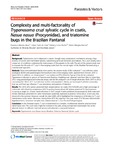Please use this identifier to cite or link to this item:
http://www.alice.cnptia.embrapa.br/alice/handle/doc/1048499Full metadata record
| DC Field | Value | Language |
|---|---|---|
| dc.contributor.author | ALVES, F. M. | pt_BR |
| dc.contributor.author | LIMA, J. S. | pt_BR |
| dc.contributor.author | ROCHA, F. L. | pt_BR |
| dc.contributor.author | HERRERA, H. M. | pt_BR |
| dc.contributor.author | MOURAO, G. | pt_BR |
| dc.contributor.author | JANSEN, A. M. | pt_BR |
| dc.date.accessioned | 2016-07-08T11:11:11Z | pt_BR |
| dc.date.available | 2016-07-08T11:11:11Z | pt_BR |
| dc.date.created | 2016-07-08 | pt_BR |
| dc.date.issued | 2016 | pt_BR |
| dc.identifier.citation | Parasites & Vectors, v. 9, n. 378, p. 1-9, 2016. | pt_BR |
| dc.identifier.uri | http://www.alice.cnptia.embrapa.br/alice/handle/doc/1048499 | pt_BR |
| dc.description | Trypanosoma cruzi is dispersed in nature through many transmission mechanisms among a high diversity of vectors and mammalian species, representing particular behaviors and habitats. Thus, each locality has a unique set of conditions underlying the maintenance of this parasite in the wild. The aim of the present study was to evaluate the life-cycle of T. cruzi in free-ranging coatis from the central region of the Brazilian Pantanal using a multi-factorial approach. Three methodological blocks were used in the present study: (i) We evaluated T. cruzi infection using serological (ELISA) and parasitological (hemoculture) tests in free-ranging coatis captured from October 2010 to March 2012. In addition, we characterized T. cruzi isolates as DTUs (Discrete Typing Units); (ii) We evaluated Trypanosoma infection in species of Triatoma and Rhodnius inhabiting coati arboreal nests from May to September 2012 using parasitological and molecular assays; and (iii) We analyzed a set of longitudinal data (from 2005 to 2012) concerning the effects of T. cruzi infection on this coati population. Herein, we investigated whether seasonality, host sex, and host age influence T. cruzi prevalence and patterns of infection. The 2010?2012 period presented high seroprevalence on coatis (72.0 % ELISA) and a high percentage of individuals with infectivity competence (20.5 % positive hemoculture). All isolates presented TcI band patterns, occurring in single (n = 3) and mixed infections (1 TcI/T. rangeli; 4 with undefined characterization). Both male and female individuals presented the same transmission potential, expressed as positive hemoculture, which was only detected in the summer. However, overall, the data (2005?2012) highlighted the importance of females for T. cruzi maintenance in the winter. Moreover, twenty-three (67.6 %) bugs from five coati nests (71.4 %) were infected with flagellated forms. Seventeen samples were characterized as T. cruzi (TcI and TcIII genotypes). In the Pantanal region, T. cruzi is transmitted in a complex, multifactorial, dynamic and non-linear transmission web. The coati nests might be inserted in this web, acting as important transmission foci at the arboreal stratum to different mammal species with arboreal or scansorial behavior. | pt_BR |
| dc.language.iso | eng | eng |
| dc.rights | openAccess | eng |
| dc.subject | Sylvatic cycle | pt_BR |
| dc.title | Complexity and multi-factoriality of Trypanosoma cruzi sylvatic cycle in coatis, Nasua nasua (Procyonidae), and triatomine bugs in the Brazilian Pantanal. | pt_BR |
| dc.type | Artigo de periódico | pt_BR |
| dc.date.updated | 2017-07-25T11:11:11Z | pt_BR |
| dc.subject.thesagro | Doença animal | pt_BR |
| dc.subject.thesagro | Vetor | pt_BR |
| dc.subject.thesagro | Trypanosoma Cruzi | pt_BR |
| dc.subject.nalthesaurus | Rhodnius | pt_BR |
| dc.subject.nalthesaurus | Disease vectors | pt_BR |
| dc.subject.nalthesaurus | Triatoma | pt_BR |
| dc.subject.nalthesaurus | Nasua nasua | pt_BR |
| riaa.ainfo.id | 1048499 | pt_BR |
| riaa.ainfo.lastupdate | 2017-07-25 | pt_BR |
| dc.identifier.doi | 10.1186/s13071-016-1649-4 | pt_BR |
| dc.contributor.institution | FERNANDA MOREIRA ALVES, FUNDAÇÃO OSWALDO CRUZ; JULIANE SAAB DE LIMA, UFMS; FABIANA LOPES ROCHA, FUNDAÇÃO OSWALDO CRUZ; HEITOR MIRAGLIA HERRERA, FUNDAÇÃO OSWALDO CRUZ; GUILHERME DE MIRANDA MOURAO, CPAP; ANA MARIA JANSEN, FUNDAÇÃO OSWALDO CRUZ. | pt_BR |
| Appears in Collections: | Artigo em periódico indexado (CPAP)  | |
Files in This Item:
| File | Description | Size | Format | |
|---|---|---|---|---|
| Alvesetal.complexityofTccicle2016.pdf | 1,56 MB | Adobe PDF |  View/Open |









